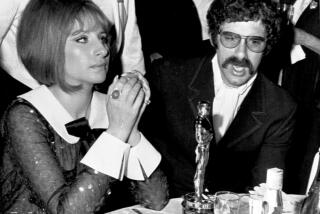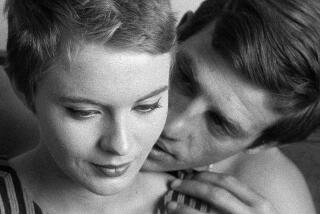Inventor Beams Over Laser Patents : After 30 Years, Gordon Gould Gets Credit He Deserves
- Share via
WASHINGTON — Gordon Gould is the kind of person you look at and, knowing what he’s been through, still say he’s none the worse for the wear.
Then again, maybe he created this contented persona to hide decades of anger. He’s frequently asked if he’s bitter, and he always smiles a little ruefully and says: “No.”
Perhaps that is because he is now a very rich man.
He’s 67, and it shows in the lines on his face, the gray in his hair--which has gracefully receded to the top of his head. But it’s not apparent that a patent struggle that dates back to 1957 has taken any visible toll.
It was 30 years ago in November that he ran into a candy store in the Bronx to get the owner, a notary public (coincidentally named Jack Gould, but no relation), to notarize the pages of research that bore Gordon Gould’s concept for harnessing light into a highly concentrated beam, a tool he named by describing the process: Light Amplification by Stimulated Emission of Radiation. Or: Laser.
He lost out on early credit for the invention and possibly even the Nobel Prize--both of which went to Charles Townes (who shared the 1964 Nobel Prize in physics with two Russian scientists for work on lasers and masers).
But now Gould is sitting in a suite at a hotel here, chain-smoking as he has for years, black-framed glasses over blue eyes full of contentedness, and there’s a grin.
‘Back-to-Back Triumphs’
He’s talking about “back-to-back triumphs.” One was winning a suit against a Florida company for back royalties on the laser. And the other: On Nov. 16 “I signed a licensing agreement (with a Long Island company) with a down payment of $1.2 million, which was a direct consequence of this trial in Florida,” he says. “And others are being negotiated.”
Gordon Gould is not even sure how wealthy he is.
“It’s very hard to measure that,” he says with an awkward laugh.
Oh, guess.
“All right, uh, let us make one kind of calculation.” The California-based Patlex Corp. (a patent enforcement company that has moved into high technology) has a 64% interest in the Gould patents. Gould, a vice chairman of Patlex, has 20% of the rights to his patents. And right now, his patents are worth about $75 million. “I’m worth about $20 million,” he says with a sheepish laugh.
He also has investments in venture-capital projects (“I can’t keep away . . . because it’s always exciting to be part of starting a company”) and high-tech companies, and estimates his worth from those at $3 million to $4 million.
(He says that Black Monday did not chisel away much of his holdings. “I’ve been burned so many times in the stock market that I was smart enough this time not to be in it very heavily.”)
And because the laser business has become so widespread in the past few years, it’s actually more lucrative for him to have his patents now than it would have been during the 1960s and early 1970s.
“By a factor of 20 to 30,” Gould confirms.
In early November, at a small presentation and press conference in the National Press Building here, Gould was awarded his latest laser patent (he has several now) for the gas-discharge laser.
Sen. Arlen Specter (R-Pa.), a friend of one of the founders of Patlex Corp. and someone who took an interest in Gould’s plight, did the honors.
Patlex officials praised Gould’s “tenacity” and described how he “waged the fight” for his patent rights.
And this is all true. But there’s still pain and anger when he talks about the U.S. Patent and Trademark Office.
He was a graduate student in physics at Columbia (with an undergraduate degree in physics from Union College and a master’s in physics from Yale), a talented inventor (he holds 48 patents) when he conceived the laser in 1957 and had his notebooks notarized. However, he mistakenly believed he needed to have a working model before he could get a patent.
“Of course, I was wrong,” he says. “Ignorant. Totally ignorant in those days. I’ve learned a lot in the last 30 years.”
The next year, 1958, Charles Townes, then a Columbia professor who had seven years earlier invented the maser (microwave amplification by stimulated emission of radiation), wrote an article on the subject of lasers with his brother-in-law, physicist Arthur Schawlow.
It was the Townes-Schawlow team who received the first patent for a laser. (Townes is now a professor emeritus at the University of California, Berkeley, and Schawlow is a professor at Stanford.)
A Blow for Gould
Gould’s own patent submission in 1959 covered several areas of work on the laser--”My first patent application had 10 different inventions in it”--most of which were different from what Townes and Schawlow submitted. (The Patent Office issues only one patent for one invention.) But it was a blow for Gould that his was not the patented invention that would introduce lasers to the public.
“I was disappointed in myself because I had done this stupid thing of not simply sitting down and writing a patent application,” Gould says. “If I had done that, I would have had that first patent.”
It took 18 years for the Patent Office to consider Gould’s various laser inventions and compare them with competing applications. The proceeding in which the Patent Office decides which inventors with overlapping claims get title is called an “interference.”
“That’s one of my biggest complaints about the Patent Office,” Gould says. “Those interferences cost money and time, and no individual could possibly carry through all that.”
Gould believes that the purpose of the patent process--to encourage inventors to get their ideas into the marketplace--”has been perverted . . . if it takes 18 years to get a patent. And it’s because bureaucratic regulations are creepy and awkward.”
Gould has won several patents on different laser inventions: “For example, there’s an optically pumped laser. You shine light on the rod to excite it. That’s the subject of the patent that was issued in 1977. The patent that’s just been issued now is on gas-discharge lasers, which are excited by running an electric current through a gas. That’s a different kind of laser,” says Gould.
Oversimplified
In the end, Gould points out, “everybody makes the mistake of oversimplifying and saying: ‘Oh, they got the laser, and you didn’t get anything.’ Well, that’s not true. They got one patent on a form of laser. I got patents on various ways of exciting lasers.
“It’s a big, complicated field,” Gould says. “There are over 10,000 people working in this field now. There’ve been at least 20,000 articles written in the past 30 years on all different kinds of aspects of lasers, three or four technical journals devoted solely to this topic.”
He also holds four patents related to lasers, and another is pending--all stemming from the original application filed in 1959. “I was 39 years old then. Today I’m 67,” he says with a chuckle.
He describes the time between filing for a patent and receiving his first one as “busy.”
After he left Columbia in 1958 (he never finished his Ph.D. work), Gould went to a company called TRG and pursued his laser work there until he was booted off it. He had written a proposal to the Defense Department for funds; the Pentagon, interested in developing a so-called “death ray,” gave the project $1 million--and classified it.
A dalliance with a Marxist study group the previous decade cost Gould the necessary security clearance to work on the project with his own notebooks, which the government classified and confiscated. (Three years later the government declassified the notebooks, which Gould had copied.)
Gould carried on at TRG, working on lasers when he could. A newspaper account from the late ‘60s says he was so obsessed with his laser research that it broke up his second marriage. “I won’t say why my marriage broke up, but it wasn’t that,” he says. His second wife, a biophysics professor, is dead.
He left TRG in 1967 to become a professor at the Polytechnic Institute of New York in Farmingdale.
He quit in 1973--”I got bored with it”--and invested in a Gaithersburg, Md.-based company, Optelecom Inc., which he helped found. He sold his interest in Optelecom and left the company two years ago.
First Patent
His first patent came through in 1977 with the help of engineer and patent attorney Richard Samuel, who is now chairman of Patlex Corp. Under the aegis of Gould’s patents, Patlex negotiates licenses with laser companies and sues or seeks remedies from infringing companies that have not been cooperative.
During the past year, Gould says, he received about $200,000 for his share from licenses. “But the expenses this year have been rather staggering. You can’t realize how much it costs to run one of these litigations. To get a battery of lawyers into a courtroom and do all the planning and running the war room and so on costs $500,000.”
Eventually, Gould and Patlex could conceivably make 5% royalties on what Gould predicts will be a $600-million laser business next year.







